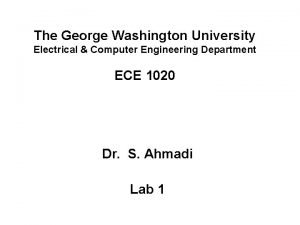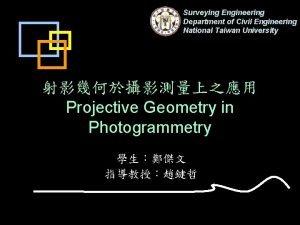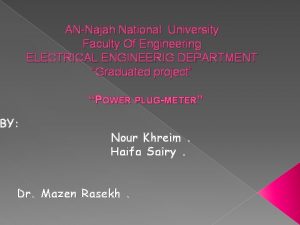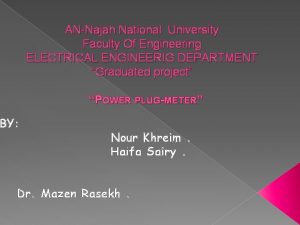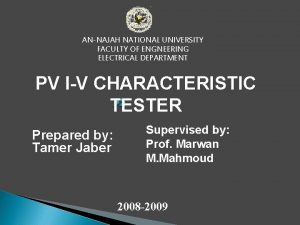AnNajah National University Faculty of engineering Electrical Engineering
















- Slides: 16

An-Najah National University Faculty of engineering Electrical Engineering Department Graduation Project 1 “Demand-Side Management System for Autonomous DC Microgrid for building” Authors: 1 - Majdi Mazen Dweikat 2 - Abdallateef Abu Lebdeh 3 - Rasheed Hattab 4 - Jalal Hattab Supervisor: Dr. Moien Omar Date: 27 May 2020

Abstract This report proposes a simulation for demand-side management (DSM) scheme for the autonomous DC microgrid for the future building. The DC distribution system is considered as a prospective system due to the increase of DC loads and DC power sources such as photovoltaic (PV), and battery bank (BB), The BB responds to the changes in a power imbalance between PV generation and demand within an autonomous DC microgrid. The power loss during charging/ discharging of the battery is the great challenge for the autonomous DC microgrid supplied by PV, it decreases the system efficiency. The control objective of the proposed DSM scheme is to use the PV energy more efficiently. The proposed control algorithm decreases the time period of batteries ON time, in this way it decreases the charging/discharging cycles of the batteries, this is reducing the power losses in the battery and improves system efficiency. The proposed scheme reduces the storage and capital cost of the system.

Building and designing dc microgrid on PV SYST We used PVsyst program to simulate our DC microgrid and specify all the components such as the user needs and the loads in the house and the operating time for each load, size of the PV, the number of batteries and the AH we need, and the controller used.

PV Sizing up Batteries The PV watt-hours needed per day is the combination of the total power consumption in the appliances and power losses in the system. The total load power is 230 w. We assumed the operating hours per day for every load as below: Lights-12 Hrs. per day Fans-Heaters-12 Hrs. per day for summer and winter (variable value but we are taking the worst cases). Washing machine 1. 5 Hrs. per day Water pump-0. 5 Hrs. per day. So, the total energy in (WH) for the loads is 1210 WH. *Solar radiation (Peak sun hour) is 5. 4 KWH/m 2. day *panels efficiency is 0. 95. 1210/ (5. 4*0. 95) =235 WP taking into consideration the losses on the system, so we choose the PV size to be 400 WP. 2 modules in series/200 W/23 V. *Days of Autonomy means How many days will the solar system run without sunshine? *Annual correction factory compensates the fact that batteries will not be new forever, but their maximum power will be less over the years. Total load consumption is 1210 WH. To find the AH-1210 WH/12 V=100. 83 AH. Batteries needed=#of AH needed*days of autonomy*Annual correction factor/DOD Batteries needed = 100. 83* 3 * 1, 15 / 0, 8 = 435 Ah. So, for our project, we chose 3*151 AH Lead-acid batteries, 12 volt all in parallel so we can keep the system at 12 V. Solar Charge Controller MPPT 1000 W12 V37 A max. charging.

Algorithm The proposed algorithm considers some a priori rules and correlations to choose the best course of action and estimate the parameter values.

MATLAP code MATLAB Code for the Conventional scheme

MATLAB Code for the DSM scheme 1

Results Sunny day



Results Non-Sunny day



DSM with a smaller number of batteries

Conclusion This paper presented a demand-side management (DSM) scheme for the autonomous DC micro grid of a residential building. The appliances have been automatically switching ‘ON’/ ‘OFF’ as per the control algorithm. The performance of the DSM scheme has been tested in terms of efficient utilization of the PV energy by scheduling the loads according to its priority Through the results we noticed the difference

Thank you
 Clemson university electrical engineering
Clemson university electrical engineering Usf canvas
Usf canvas Igor dujlovic
Igor dujlovic Studis.fe
Studis.fe Panti asuhan annajah
Panti asuhan annajah Logo annajah
Logo annajah Annajah motors
Annajah motors Annajah motors
Annajah motors Faculty of engineering university of porto
Faculty of engineering university of porto Faculty of engineering lebanese university
Faculty of engineering lebanese university Faculty of mechanical engineering thammasat university
Faculty of mechanical engineering thammasat university Tel aviv university electrical engineering
Tel aviv university electrical engineering University of belgrade school of electrical engineering
University of belgrade school of electrical engineering George washington university electrical engineering
George washington university electrical engineering Tel aviv university electrical engineering
Tel aviv university electrical engineering George washington university electrical engineering
George washington university electrical engineering National taiwan university civil engineering
National taiwan university civil engineering















